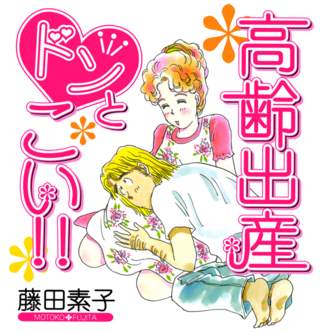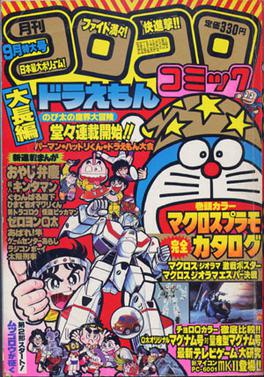Shōnen manga is an editorial category of Japanese comics targeting an audience of adolescent boys. It is, along with shōjo manga, seinen manga, and josei manga, one of the primary editorial categories of manga. Shōnen manga is traditionally published in dedicated manga magazines that exclusively target the shōnen demographic group.
Seinen manga (青年漫画) is an editorial category of Japanese comics marketed toward young adult men. In Japanese, the word seinen literally means "youth", but the term "seinen manga" is also used to describe the target audience of magazines like Weekly Manga Times and Weekly Manga Goraku which cater specifically to men's interests, and are marketed towards a demographic of young adult men between the ages of 18 and 40. Seinen manga are distinguished from shōnen manga which are for young teen boys, although some seinen manga like xxxHolic share similarities with shōnen manga. Seinen manga can focus on action, politics, science fiction, fantasy, relationships, sports, or comedy. The female equivalent to seinen manga is josei manga.

Josei manga, also known as ladies' comics (レディースコミック) and its abbreviation redikomi , is an editorial category of Japanese comics that emerged in the 1980s. In a strict sense, josei refers to manga marketed to an audience of adult women, contrasting shōjo manga, which is marketed to an audience of girls and young adult women. In practice, the distinction between shōjo and josei is often tenuous; while the two were initially divergent categories, many manga works exhibit narrative and stylistic traits associated with both shōjo and josei manga. This distinction is further complicated by a third manga editorial category, young ladies (ヤングレディース), which emerged in the late 1980s as an intermediate category between shōjo and josei.

Weekly Shōnen Jump is a weekly shōnen manga anthology published in Japan by Shueisha under the Jump line of magazines. The manga series within the magazine consist of many action scenes and a fair amount of comedy. Chapters of the series that run in Weekly Shōnen Jump are collected and published in tankōbon volumes under the Jump Comics imprint every two to three months. It is one of the longest-running manga magazines, with the first issue being released with a cover date of August 1, 1968.

Weekly Shōnen Sunday is a weekly shōnen manga magazine published in Japan by Shogakukan since March 1959. Contrary to its title, Weekly Shōnen Sunday issues are released on Wednesdays. Weekly Shōnen Sunday has sold over 1.8 billion copies since 1986, making it the fourth best selling manga magazine, only behind Weekly Shōnen Jump, Weekly Shōnen Magazine and Weekly Young Jump.

Shogakukan Inc. is a Japanese publisher of dictionaries, literature, comics (manga), non-fiction, DVDs, and other media in Japan.

Weekly Shōnen Magazine is a weekly shōnen manga anthology published on Wednesdays in Japan by Kodansha, first published on March 17, 1959. The magazine is mainly read by an older audience, with a significant portion of its readership falling under the male high school or college student demographic. According to circulation figures accumulated by the Japanese Magazine Publishers Association, the magazine's circulation has dropped in every quarter since records were first collected in April–June 2008. This is, however, not an isolated occurrence as digital media continues to be on the rise.

CoroCoro Comic is a Japanese monthly manga magazine published by Shogakukan; established on May 15, 1977. Its main target is elementary school-aged boys. Several of its properties, like Doraemon and the Pokémon series of games, have gone on to be cultural phenomena in Japan.

Akira Amano is a Japanese mangaka known for the shōnen series Reborn!.

Jump Square, also written as Jump SQ. (ジャンプSQ.), is a Japanese monthly shōnen manga magazine. Published by Shueisha, the magazine premiered on November 2, 2007 as a replacement for Monthly Shōnen Jump, another manga anthology that Shueisha discontinued in June of that year. The magazine is a part of the Jump line of magazines. The manga titles serialized in the magazine are also published in tankōbon volumes under the Jump Comics SQ. imprint. Shueisha reported that readers of Jump Square tend to range from 15 to 34 years of age. The current (2015) editor-in-chief is Kôsuke Yahagi.
Gutsoon! Entertainment, Inc. was a publisher of English translated manga. The company, headquartered in Encino, Los Angeles, served as the US subsidiary of Coamix, which was founded by Nobuhiko Horie and manga artist Tsukasa Hojo.

Shonen Jump, officially stylized SHONEN JUMP and abbreviated SJ, was a shōnen manga anthology published in North America by Viz Media. It debuted in November 2002 with the first issue having a January 2003 cover date. Based on Shueisha's popular Japanese magazine Weekly Shōnen Jump, Shonen Jump is retooled for English readers and the American audience, including changing it from a weekly publication to a monthly one. It features serialized chapters from four manga series, and articles on Japanese language and culture, as well as manga, anime, video games, and figurines. Prior to the magazine's launch, Viz launched an extensive marketing campaign to promote it and help it succeed where previous manga anthologies published in North America had failed. Shueisha purchased an equity interest in Viz to help fund the venture, and Cartoon Network, Suncoast, and Diamond Distributors became promotional partners in the magazine.
Shōnen, shonen, or shounen is the Japanese word for "boy" or "minor".
Go Nagai is a prolific Japanese manga artist who has written, illustrated, or otherwise contributed to over 360 manga titles since his professional debut in 1967 with Meakashi Polikichi. Specializing in science fiction, fantasy, horror, and erotica, he is best known for creating the seminal works Cutie Honey, Devilman, and Mazinger Z in the 1970s.

Shueisha Inc. is a Japanese company headquartered in Chiyoda, Tokyo, Japan. Shueisha is the largest publishing company in Japan. It was established in 1925 as the entertainment-related publishing division of Japanese publisher Shogakukan. The following year, Shueisha became a separate, independent company.

Kodansha Ltd. is a Japanese privately held publishing company headquartered in Bunkyō, Tokyo. Kodansha publishes the manga magazines Nakayoshi, Afternoon, Evening, Weekly Shōnen Magazine and Bessatsu Shōnen Magazine, as well as the more literary magazines Gunzō, Shūkan Gendai, and the Japanese dictionary Nihongo Daijiten. Kodansha was founded by Seiji Noma in 1910, and members of his family continue as its owners either directly or through the Noma Cultural Foundation.
Jogaku Sekai was a Japanese women's magazine published by Hakubunkan in Tokyo, Japan. It was in circulation between January 1901 and June 1925 during late Meiji era. The magazine became very popular among the Japanese women and was the highest circulation title of Hakubunkan. It was the first Japanese periodical in which schoolgirl speech was covered.











